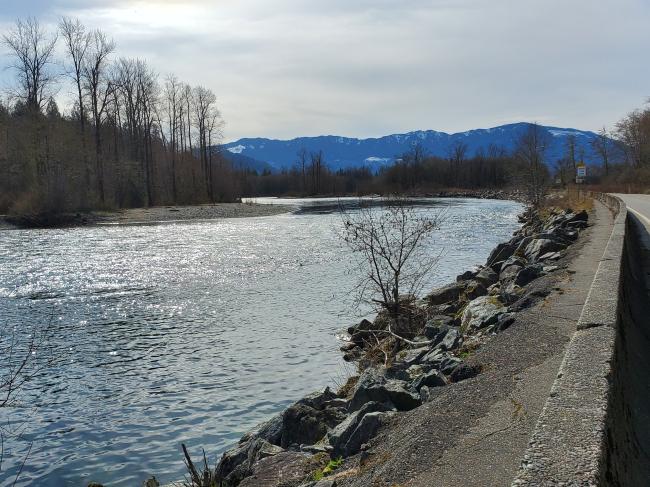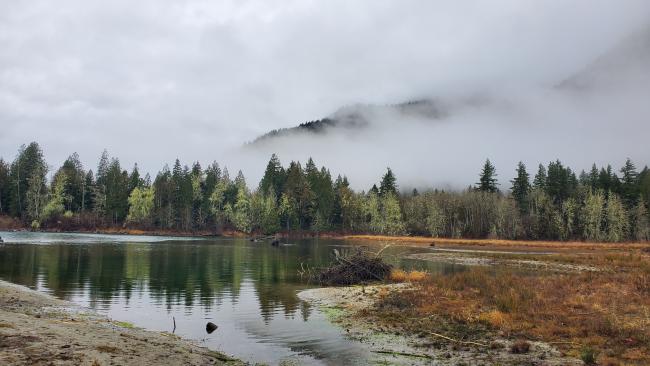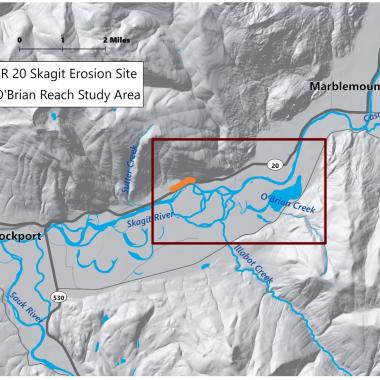Planning study news
In 2020, WSDOT received a Salmon Recovery Funding Board (SRFB) grant to characterize and assess existing riverine and floodplain conditions in the Skagit River, and explore a floodplain restoration alternative as a potential solution to reduce flood and erosion damage to State Route 20 and improve native fish habitat in the river and its floodplain.
The feasibility study and report were completed in December 2023, and the report is available for viewing and download below.
Purpose
The SR 20 Skagit River O’Brian Reach Feasibility Study area is located along SR 20 near Rockport at milepost 101. This section of SR 20 experiences frequent embankment erosion and flooding and has required repeated emergency repairs following floods in the Skagit River. The purpose of the study was to characterize and assess floodplain connectivity, hydraulic processes, and fish habitat to determine if there is a feasible floodplain restoration action that:
- Improves degraded fish habitat in the Skagit River and its floodplain by enhancing the connectivity of floodplain habitats to the river during small and medium-sized floods.
- Reduces erosion and flood damage to SR 20 during frequent flood events and does not increase risk to adjacent property or infrastructure.
- Is acceptable to the community and feasible based on other factors, such as cost, sustainability, wildlife, recreation, aesthetics, and opportunities to collaborate.
This technical study engaged potential project partners and the public throughout the study, and the results were documented in a feasibility study report. This was not a project planning study, and the alternatives evaluated will not result in a WSDOT project proposal.
Feasibility study report
The final Skagit O’Brian Feasibility Study Report - Part 1 (PDF 28MB) and the Skagit O’Brian Feasibility Study Report - Part 2 (PDF 26MB) documents the analyses and evaluation used in the study to develop the conceptual alternatives and conceptual design.
Since the 1990’s, SR 20 near milepost 101 has experienced frequent embankment erosion and flooding and required repeated emergency repairs following floods in the Skagit River. This section of the highway is located below the 10-year flood elevation along a meander of the Skagit River that has been slowly migrating downstream.
WSDOT’s Chronic Environmental Deficiencies (CED) program was exploring solutions to address the flooding problem and sponsored the feasibility study. The purpose of the CED Program is to protect state highways from flooding and erosion at frequent repair sites by constructing climate-resilient, nature-based, fish-friendly projects. These projects aim to work with watershed processes that often occur on a large scale.
A large portion of the floodplain of the O’Brian Reach is undeveloped, dedicated to conservation use, and managed by organizations working toward salmon recovery in the basin. This presented an opportunity to collaborate with potential conservation partners on a large-scale approach that addresses both problems, instead of implementing a site-specific, bank protection structure adjacent to the highway.
The study results showed that one of the two evaluated restoration alternatives had a potential significant increase in fish habitat quantity and quality but showed only minimal reductions in flood or erosion risk to SR 20. Although the results indicate a floodplain restoration project would not significantly improve flood conditions at the highway, the study effort gathered valuable information on hydraulic processes and habitat in the reach that could inform future restoration and flood protection efforts by others.



